Where To Store Bread In The Kitchen

Bread is a staple food that has been consumed by humans for thousands of years. It is made from a combination of flour, water, yeast, and sometimes other ingredients such as sugar, salt, and fat. There are many different types of bread, including white bread, whole wheat bread, sourdough bread, and many more.
Bread can be stored in a few different ways depending on the type of bread and how quickly you plan to consume it.In this article we will share with you ways to keep it in use as long as possible
Why Bread Quickly Becomes Stale, Spoiled And Covered With Mold
Bread quickly becomes stale, spoiled, and covered with mold due to several factors:
- Moisture loss: When bread is exposed to air, it loses moisture through a process called staling. This causes the bread to become dry and crumbly, making it less palatable and enjoyable to eat.
- Bacterial growth: Bread is a high-moisture food, and when it is stored in a warm, humid environment, it can become a breeding ground for bacteria. This can cause the bread to spoil and develop an unpleasant odor or taste.
- Mold growth: Mold thrives in warm, moist environments and can quickly grow on bread that is stored improperly. Mold can cause allergic reactions in some people and can be harmful if ingested in large amounts.
To prevent bread from becoming stale, spoiled, or covered with mold, it’s important to store it properly. Keep bread in a cool, dry place, such as a bread box or pantry, and avoid storing it in a humid environment, such as the refrigerator. If you do need to store bread in the refrigerator or freezer, wrap it tightly in plastic wrap or aluminum foil to help prevent moisture loss. Finally, be sure to discard any bread that shows signs of spoilage, such as mold growth or a foul odor.
How To Properly Store Baked Goods
Here are some general tips on how to properly store baked goods:
- Cool completely: Allow baked goods to cool completely before storing. This helps to prevent moisture buildup and mold growth.
- Store in airtight containers: Store baked goods in airtight containers, such as plastic containers with tight-fitting lids or resealable plastic bags. This helps to keep the moisture in and prevents air and moisture from getting in.
- Use moisture control methods: Depending on the type of baked goods, you may need to use moisture control methods to prevent them from becoming too moist or dry. For example, add a slice of bread to the container to help maintain moisture levels, or use a paper towel to absorb excess moisture.
- Store in the right location: Store baked goods in a cool, dry place. Avoid storing them in direct sunlight or near a heat source, such as a stove or oven.
- Freeze for longer storage: If you need to store baked goods for a longer period of time, consider freezing them. Wrap the baked goods tightly in plastic wrap or aluminum foil, and place them in a freezer-safe container or resealable plastic bag. Be sure to label and date the container.
- Consider the type of baked good: Different types of baked goods require different storage methods. For example, cookies and brownies can be stored at room temperature for a few days, while bread and cakes should be stored in airtight containers to prevent them from drying out.
By following these general tips, you can help ensure that your baked goods stay fresh and delicious for as long as possible.
How Many Days Does It Stay Fresh
Commercially baked breads and rolls can be stored at room temperature for 2 to 4 days or 7 to 14 days in the refrigerator. Bread products retain their quality when stored in the freezer for 3 months.
At What Temperature
Bread should be stored at room temperature, ideally in a cool, dry place such as a bread box or pantry. The optimal temperature for storing bread is between 18-21°C (64-70°F). At this temperature range, bread will stay fresh and moist for up to 2-3 days. If you live in a particularly warm or humid climate, it’s best to store bread in a cooler location to help prevent it from becoming stale or moldy. Avoid storing bread in the refrigerator, as this can cause it to dry out quickly and become stale.

In What Room
Bread should be stored in a cool, dry room at room temperature. A pantry or cupboard is an ideal place to store bread as it will protect it from light, air, and moisture. It’s important to keep bread away from heat sources, such as the stove or oven, as this can cause it to dry out and become stale quickly. Avoid storing bread in areas of high humidity or moisture, such as the bathroom or near a window, as this can promote mold growth. A bread box is another great option for storing bread, as it will help to regulate the temperature and airflow around the bread, keeping it fresh for longer.
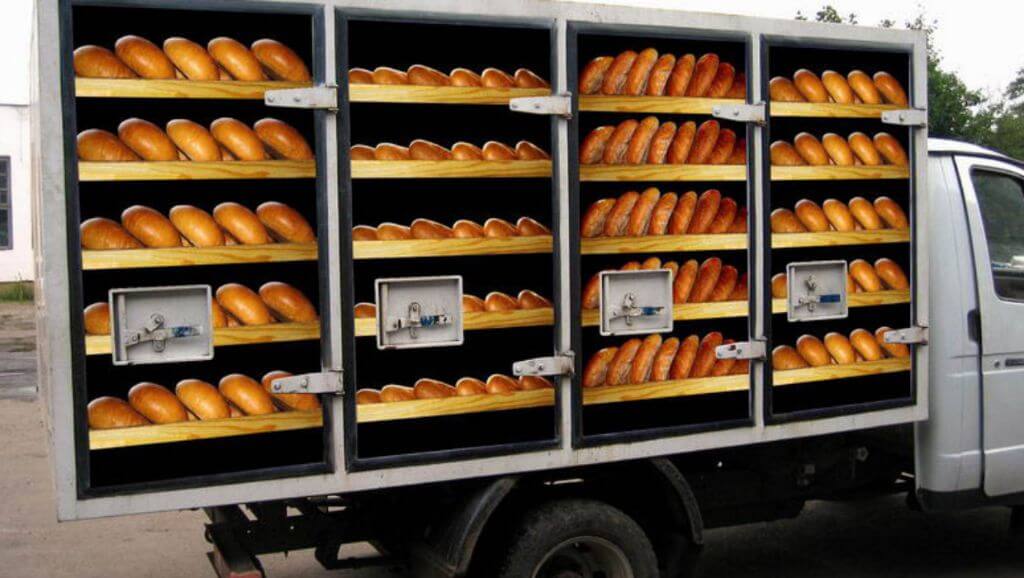
Is It Possible To Keep Different Varieties Together
Yes, it is possible to keep different varieties of bread together, but it’s important to keep in mind that some types of bread may release moisture or odors that can affect other types of bread. For example, if you store a crusty bread like a baguette with a soft bread like a sandwich loaf, the crusty bread may dry out the soft bread.
To prevent this, you can separate different types of bread by wrapping them in individual pieces of waxed paper, parchment paper, or plastic wrap. This will help to prevent any moisture or odors from being transferred between the different types of bread.
Another option is to use a bread box with separate compartments for different types of bread. This will help to keep the bread separated and prevent any moisture or odors from mixing.
In general, it’s best to store different varieties of bread separately if possible, but if you need to store them together, be sure to wrap them individually and keep them in a cool, dry place.
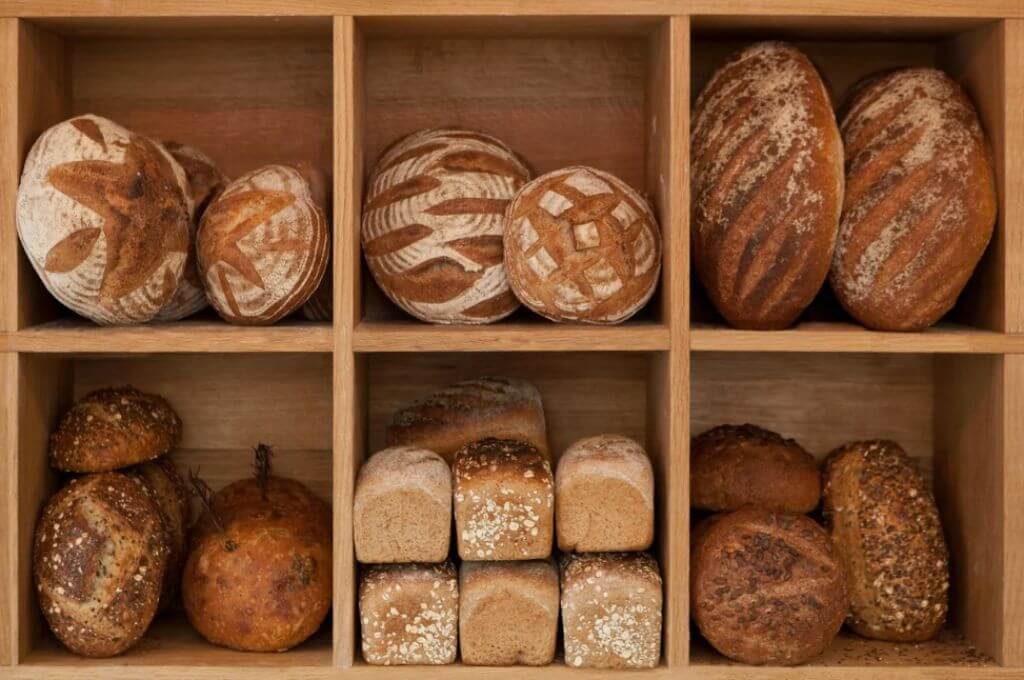
Why can’t you store different types in one place:
You can store different types of bread together in one place, but it’s important to keep in mind that different types of bread have different moisture contents and textures, and they may release moisture or odors that can affect each other.
Example:
a crusty bread like a baguette may dry out a soft bread like a sandwich loaf if they are stored together, while a bread with a high moisture content like a sourdough may make a drier bread like a rye bread go moldy if they are stored in the same container.
By storing different types of bread separately, you can help to prevent any moisture or odors from being transferred between them, and you can also help to preserve the individual flavors and textures of each type of bread.
However, if you need to store different types of bread together, be sure to wrap them individually in waxed paper, parchment paper, or plastic wrap to help prevent any moisture or odors from being transferred. You can also use a bread box with separate compartments for different types of bread to help keep them separated.
Coming to the store for bread, we always see one picture: loaves and buns lie on open wooden shelves. At home, this is not always convenient.
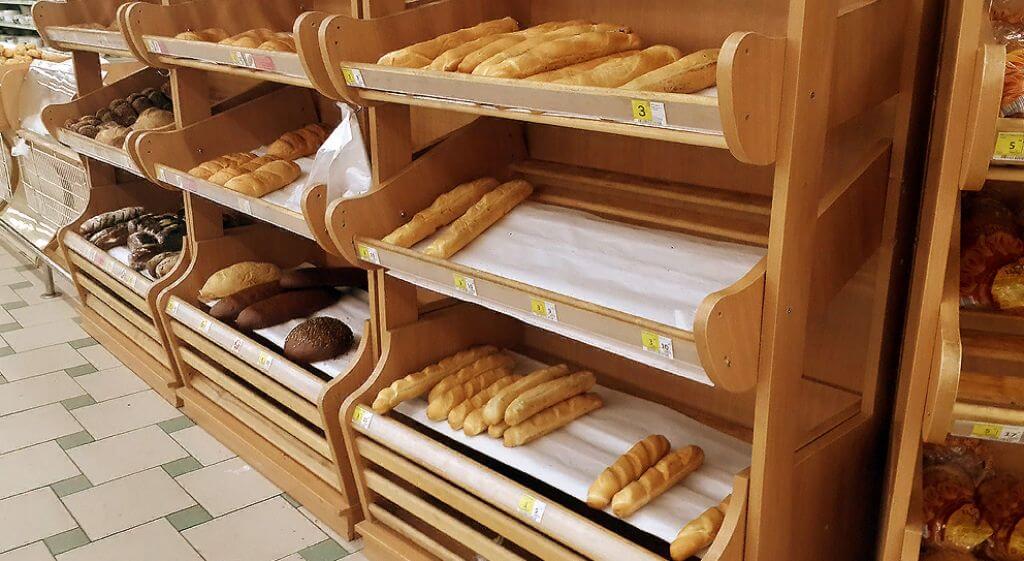
How do you keep bread fresh as long as possible? After all, we do not eat what we bought in a day. There are many storage options. You just need to choose the one where the soft crumb and crispy crust will last longer.
1. In A Fabric Bag
In linen and cotton bags, the roll will retain its natural aroma and taste for a week, but will become stale earlier than in a bread box. It is good to use the fabric for individual packaging of products made from flour of various types.
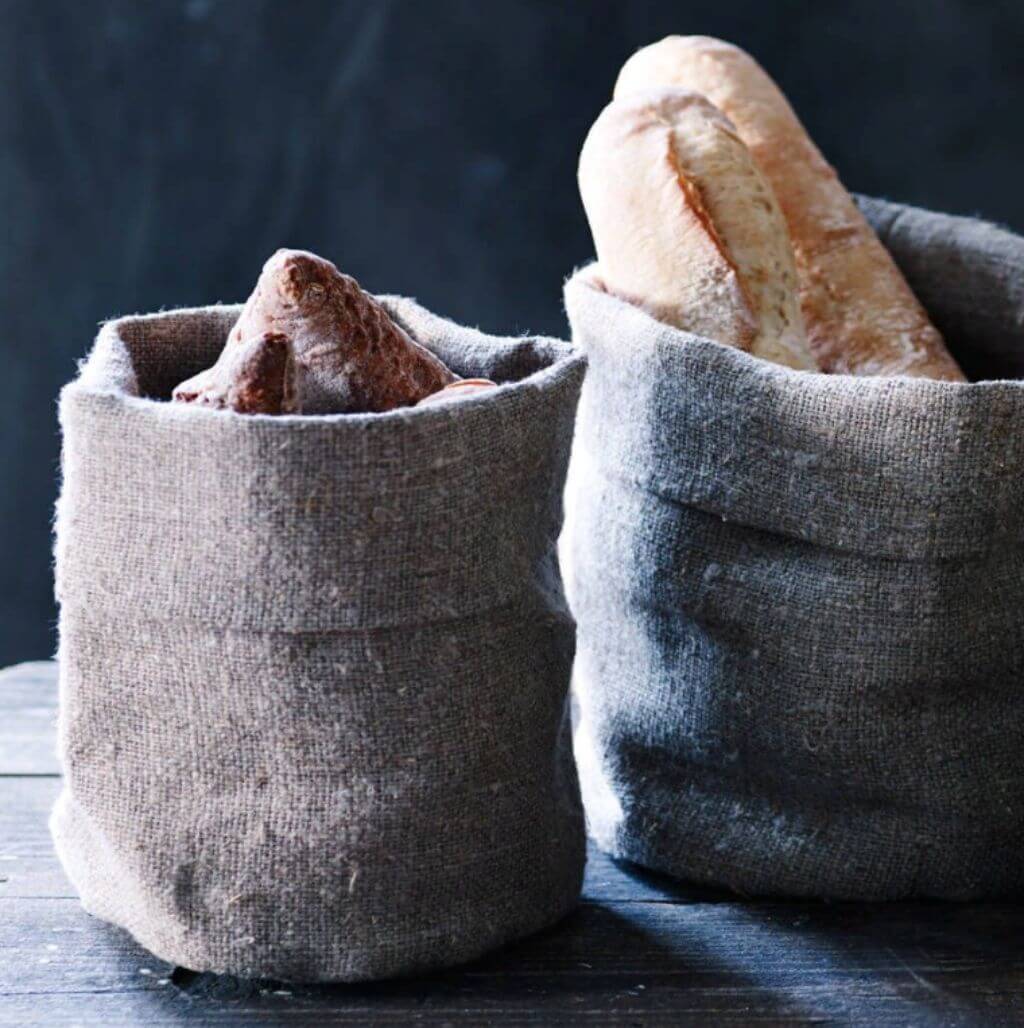
The bags are shaken out when laying a fresh loaf, and washed once a month or earlier with laundry soap in hot water, as they get dirty.
2. In Foil Or Plastic Bag
Polyethylene and foil prevent moisture loss. The main thing is that the packaging is airtight. The roll pulled out of the bread machine is first cooled, wrapped cold. Bags and foil must be dry and clean.

3. In A Refrigerator
Bread will lie in the refrigerator for three weeks. This is convenient if the family does not eat a lot of bread. Cut into portioned pieces, it does not mold for a long time and is easily refreshed in the microwave. Bread should be in polyethylene or foil – there is too much humidity in the refrigerator.
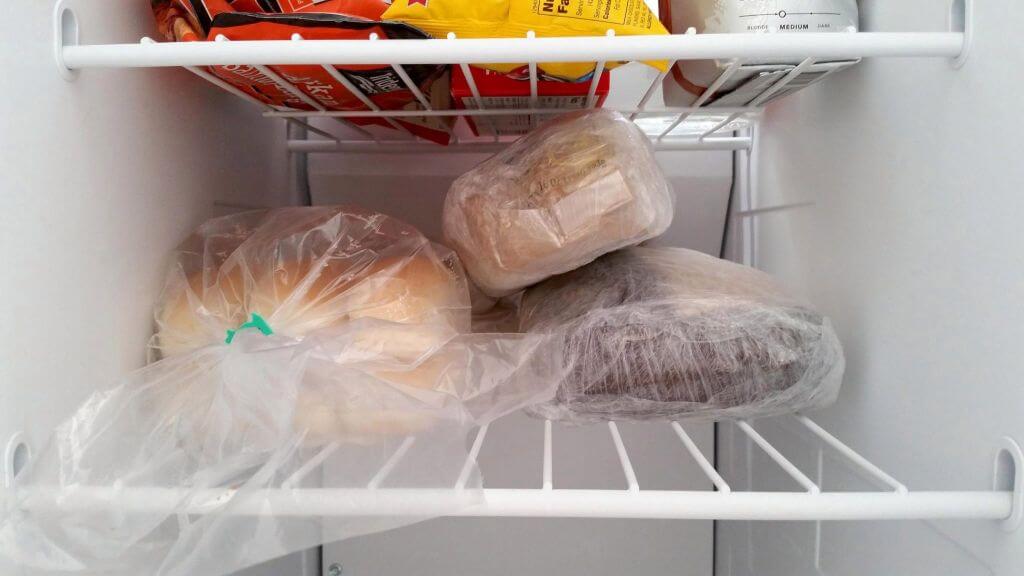
4. In The Freezer
It is good to store in the freezer when you have to leave for a long time. The bread will freeze, but after defrosting in the microwave, it will restore its original freshness.

How to freeze properly:
- portioned pieces are easier to warm without taking out the whole bun;
- freshly baked bread is kept until completely cooled and only then frozen;
- do not freeze one loaf twice, it will become watery.
5. In The Bread Box
The bread box is preferred for mobility. It can be put in a convenient place, it is easy to clean. The material and shape has a wide variety, so it will fit into any design solution.
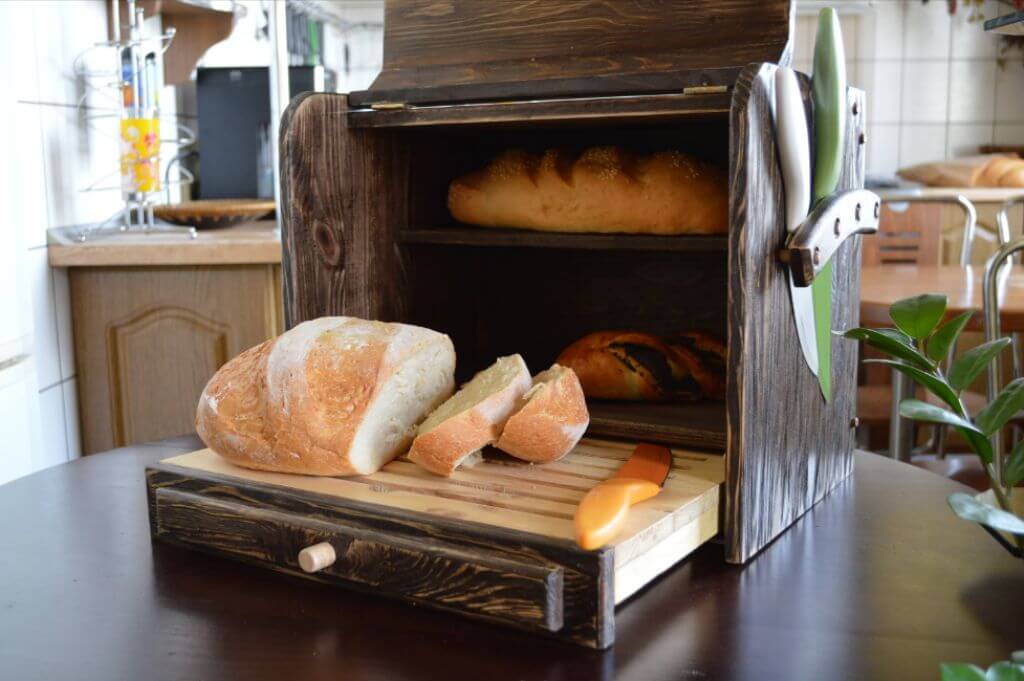
Some people prefer to remove all utensils from tables and work surfaces. In this case, the bread box can be put in a closet or make a shelf for it.
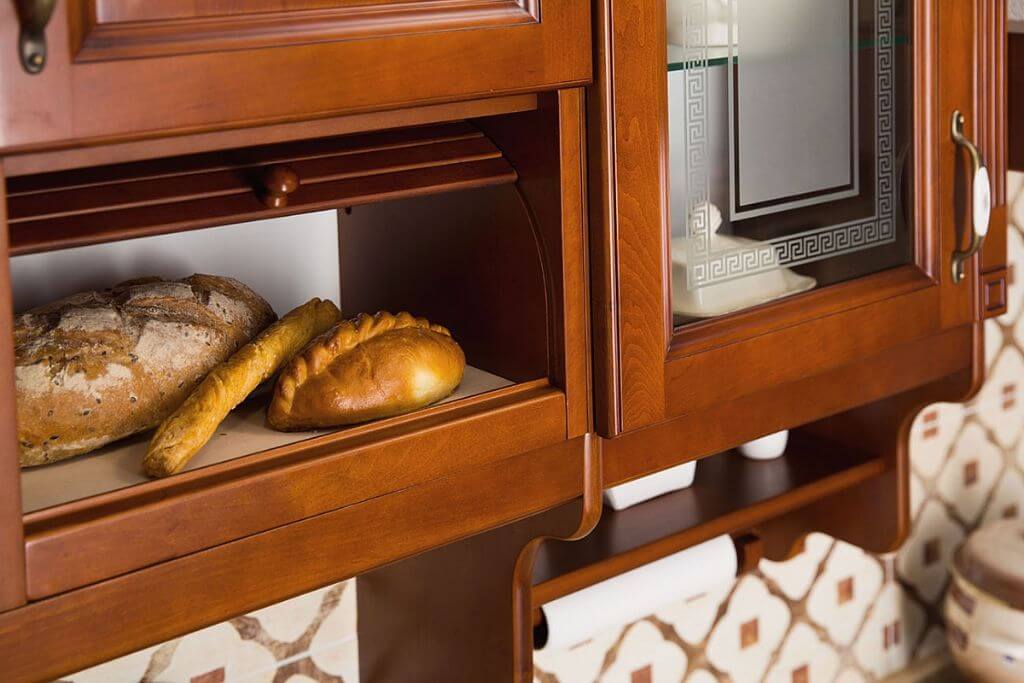
Opponents of this method of storage are annoyed by the need to regularly wash the bread box, so they prefer other options.
6. On The Shelves In The Kitchen
For those who do not want to bother with drawers and boxes, a storage shelf will appeal to ease of cleaning and spaciousness. To protect the surface from greasy stains and stains, you will have to store rolls in bags, lay napkins.
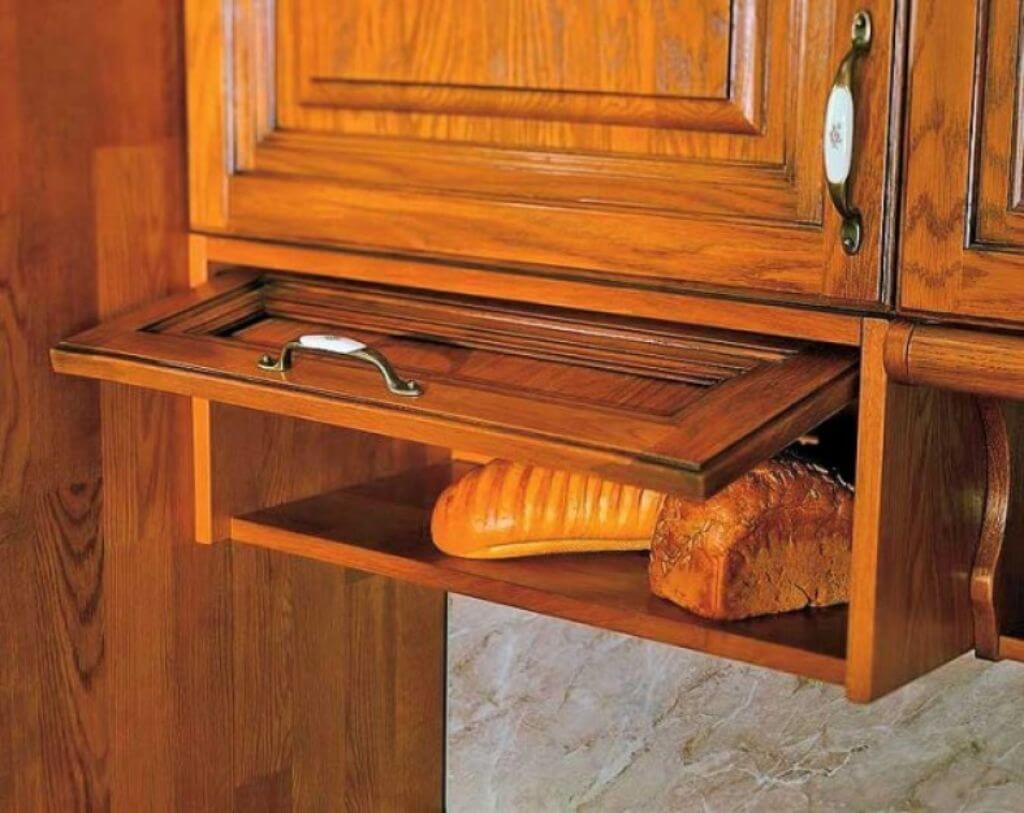
Packaging is also useful to protect against kitchen odors, which are sometimes too intrusive. The cabinet door won’t help.
7. Built-In Containers
A hole of the desired size is cut out in the counter top and a container made of wood, metal, a wicker basket is inserted. The lid is made in such a way that when closed it is flush with the entire surface. The secret compartment does not take up much space and keeps the bread well.
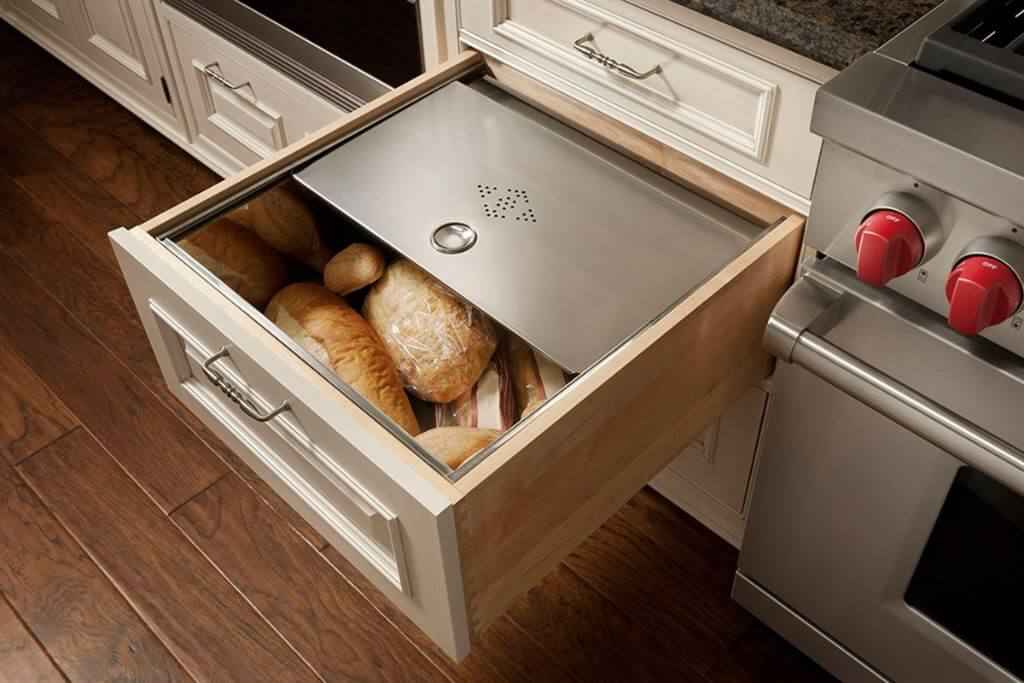
8. The Traditional Bread Box
Most housewives prefer a bread box. It justifies its purpose both in a small kitchen and in a spacious kitchen-living room. Which is better to choose a bread bin according to the design, material of manufacture is a matter of individual preferences.
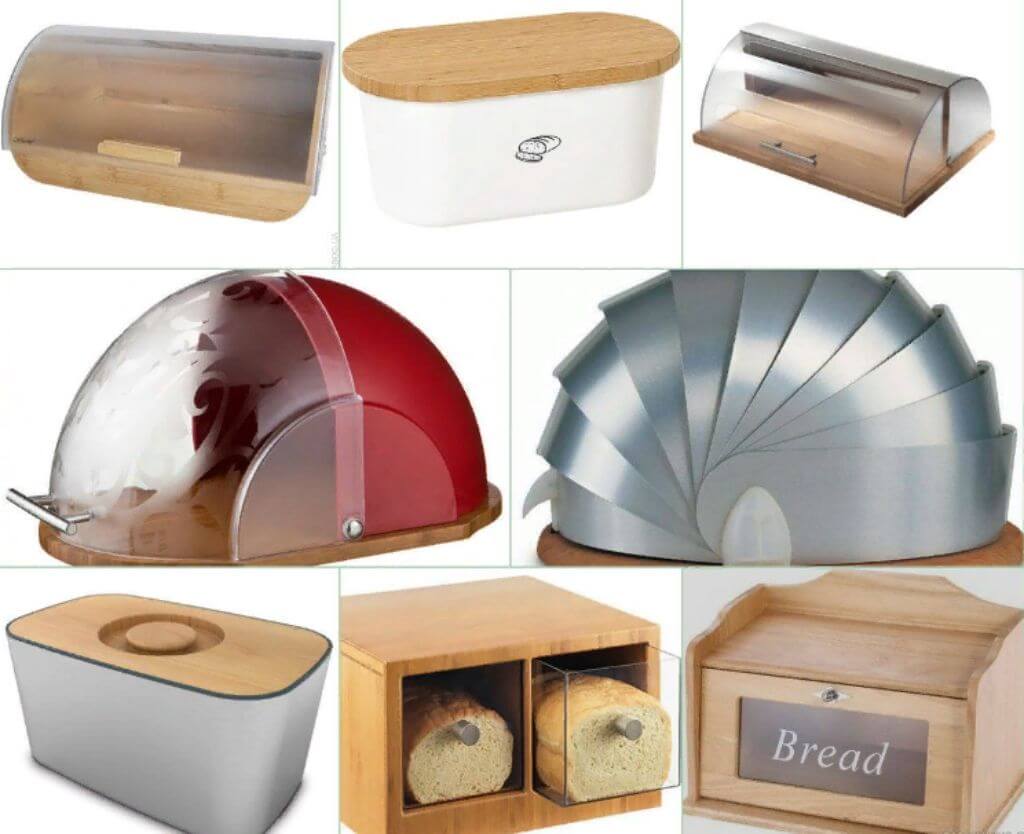
Material selection:
- plastic – as neutral in composition retains moisture and protects against odors. These same qualities contribute to the appearance of mold and stagnation of air. Treatment with acetic acid for prevention is recommended once a week;
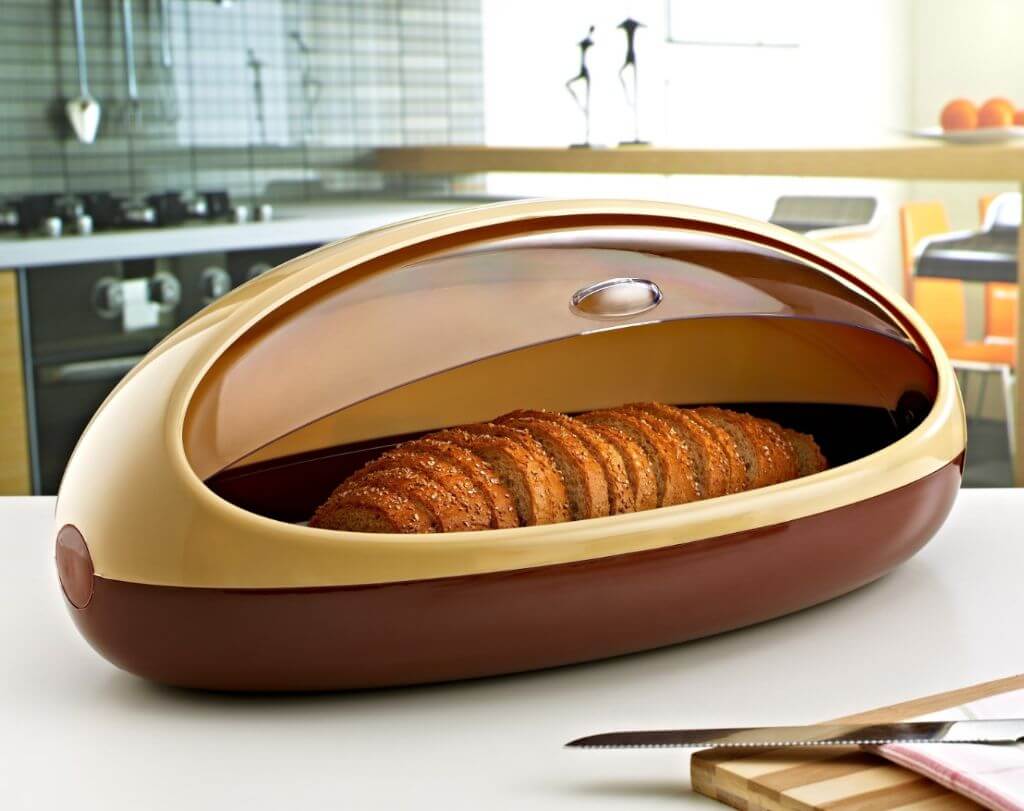
- wooden – the best bread box in terms of shelf life. If the wood has not been treated with impregnation, varnish, it does not give off odors, but, on the contrary, accumulates them in itself. To clean the top layer and disinfect, treat with boiling water once a month. Naturally, dry cleaning is carried out as needed;
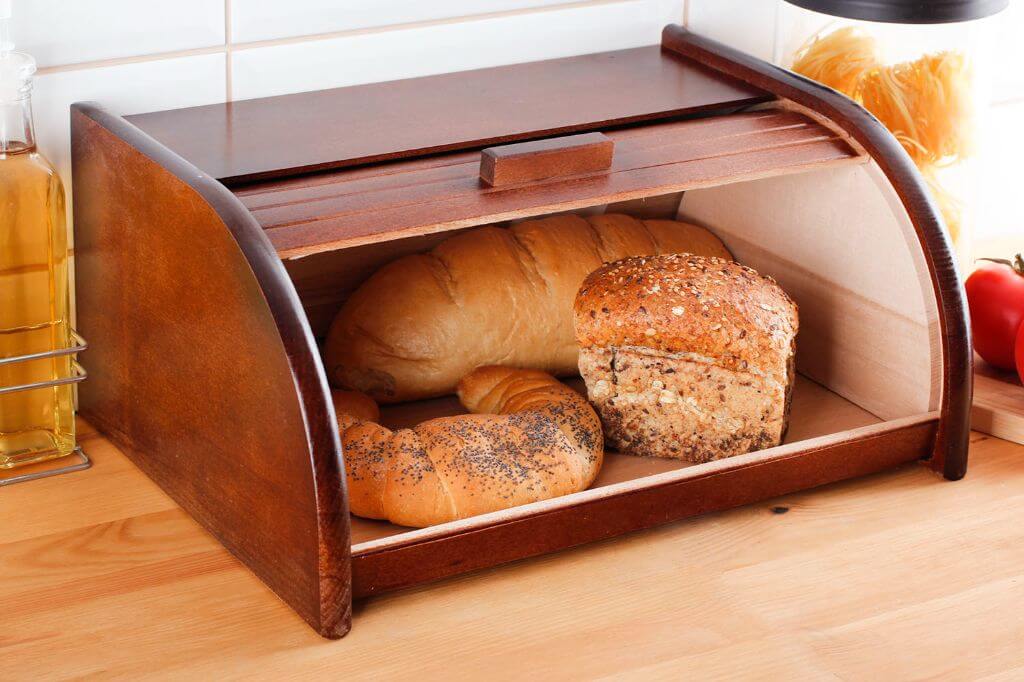
- birch bark — the original kind of bread box, retains all the advantages of the tree;
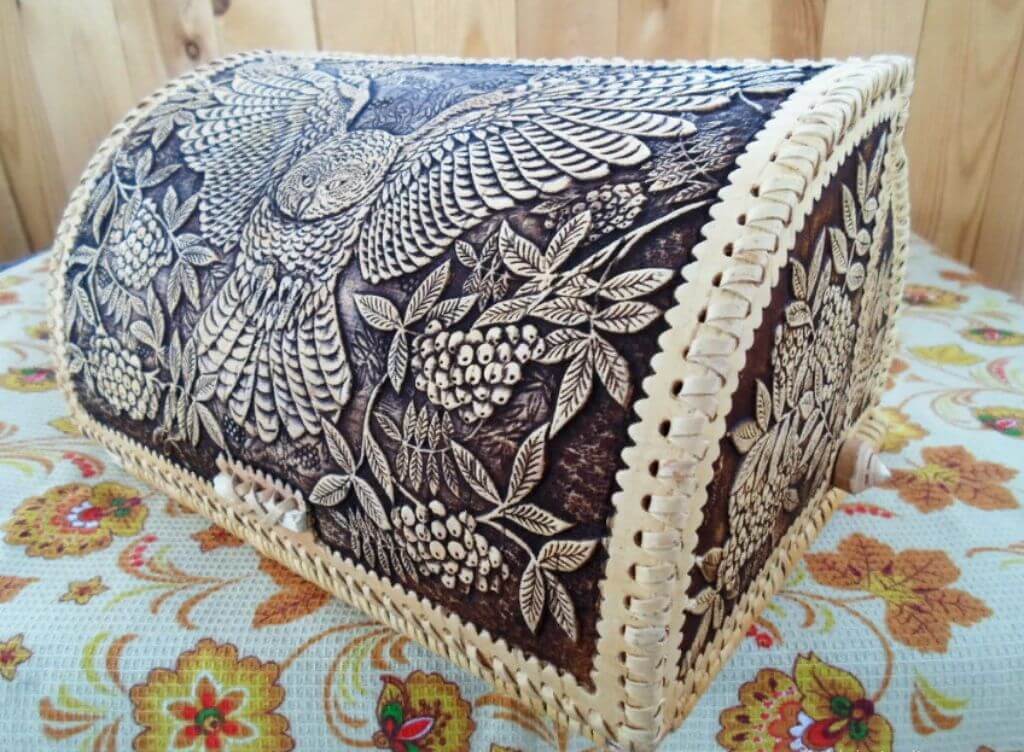
- ceramic – Utensils made of neutral material best protect the taste and aroma of any product. A ceramic pot or vase will keep the bread fresh for several days. Unglazed ones are difficult to keep clean, glazed ones are not suitable for long-term storage, as they do not allow air to pass through;

- stainless steel – for those who prefer simplicity and conciseness, as well as for neat people. The metal is easy to wipe with a clean cloth. It does not hurt to cover the bottom with a clean cotton or linen cloth, put a wooden board to preserve the taste of bread;

- glass – bread bins protect from staleness and look stylish, they do not load space in a small kitchen. Absolutely sealed, so you need to prevent the development of the fungus;
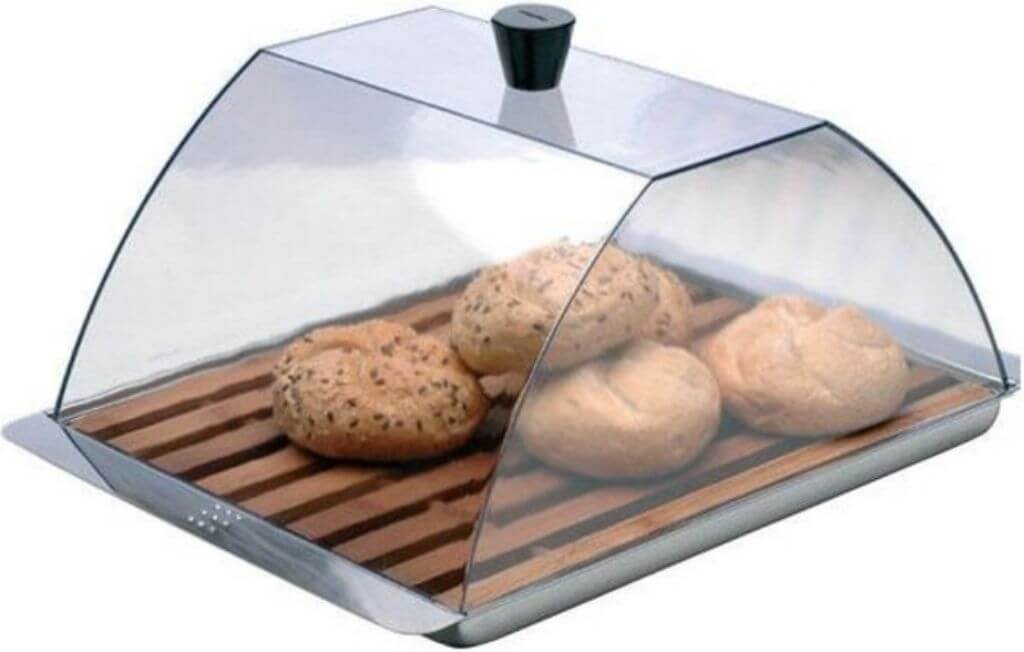
- braided – in such a container, the bread will remain soft for a maximum of a couple of days. Crumbs get stuck in the cracks. To keep the utensils clean, they cover them with a napkin, rinse with warm water and treat with boiling water or vinegar.
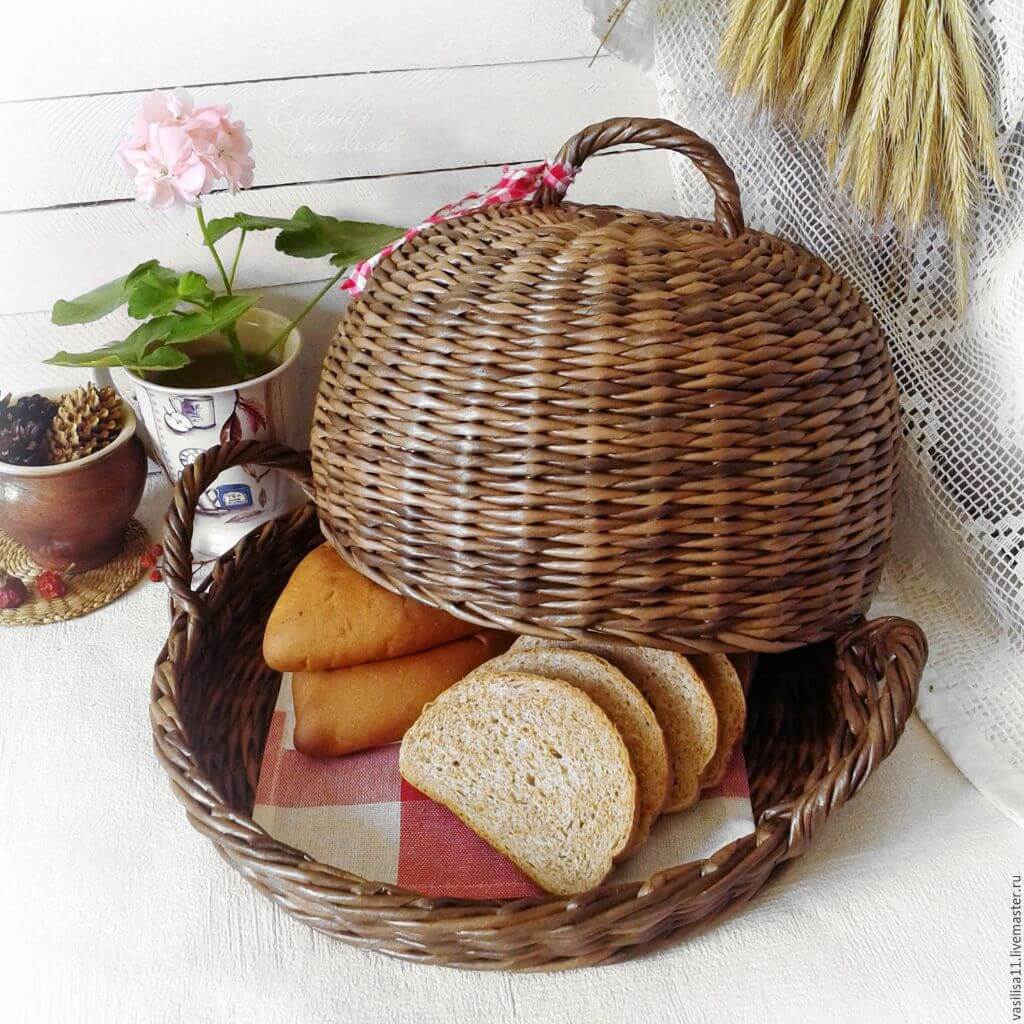
Kinds
Properly organising the workspace is all the more important, the smaller the area. We have to decide how to save space in the kitchen. Modern bread bins look good on the dining table, but sometimes they just get in the way.
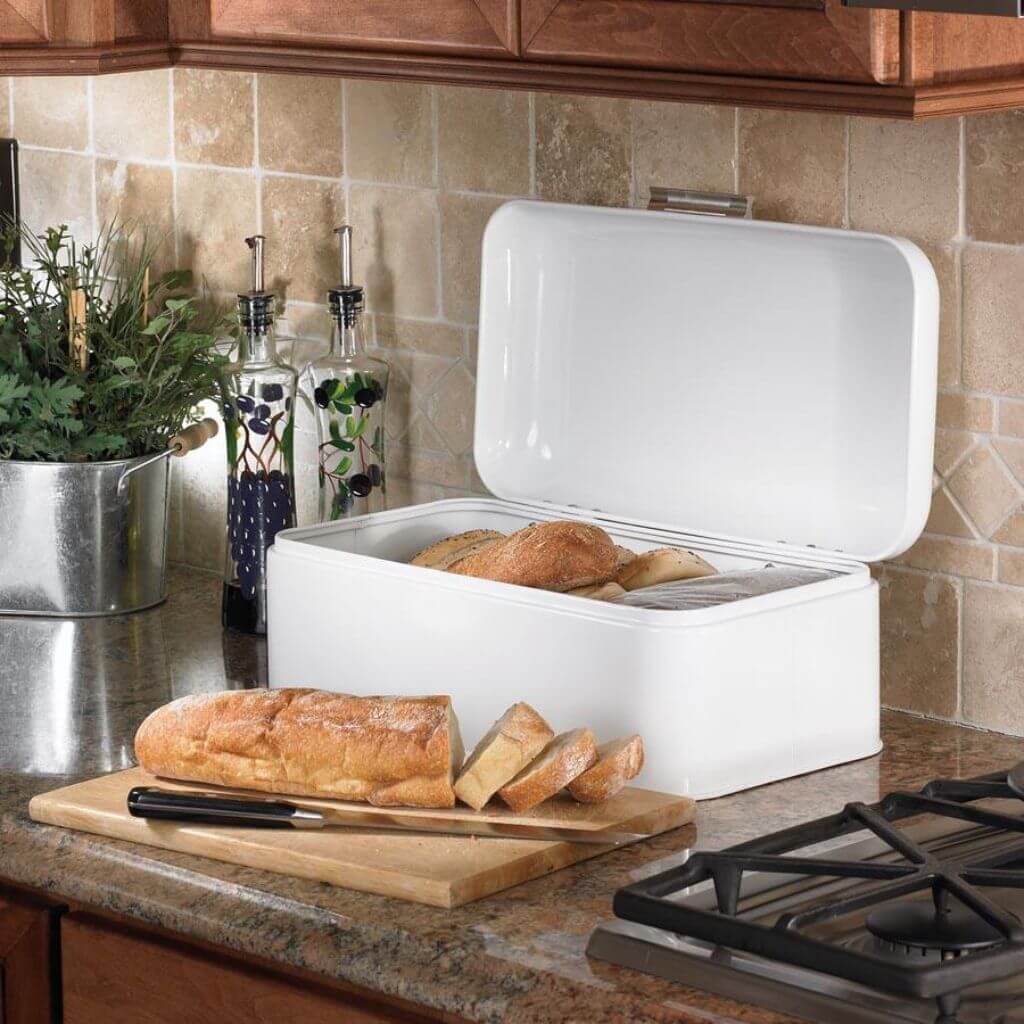
To stop worrying about where to put the bread box, you can practically arrange storage built into the kitchen. This can be an ordinary shelf with a door in the upper tier of the headset, where packaged rolls are placed or boxes with cuts are placed.
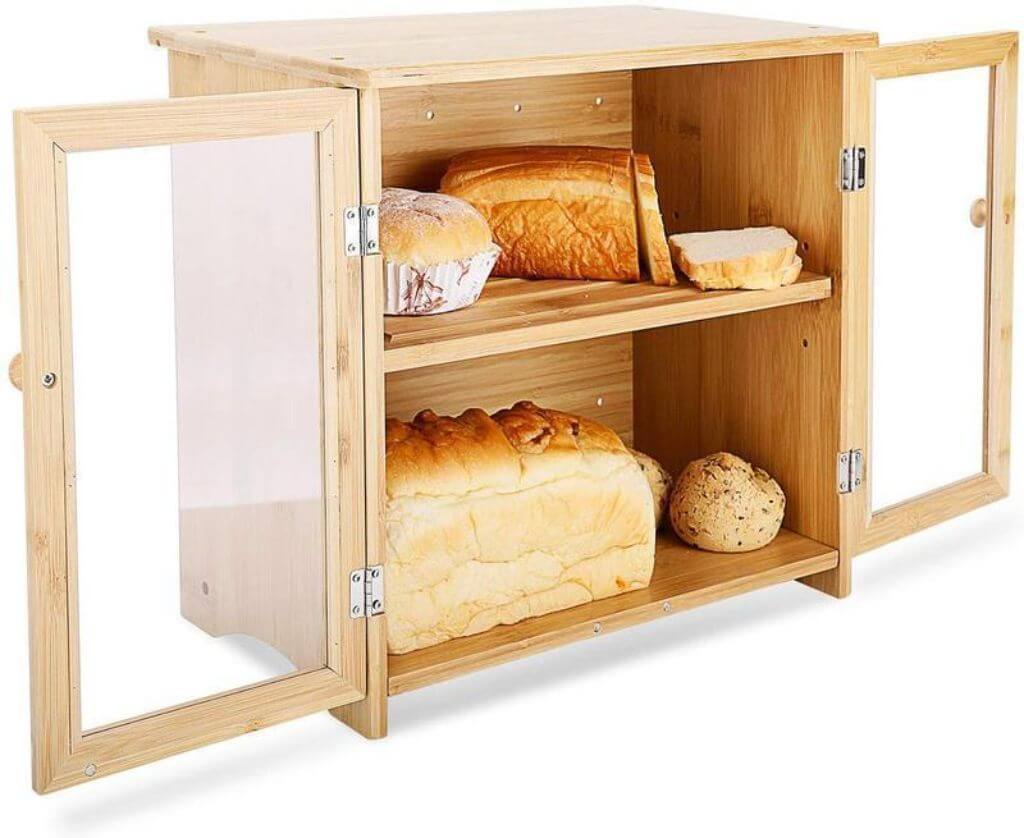
A simple solution is an open shelf for installing a compact bread box.
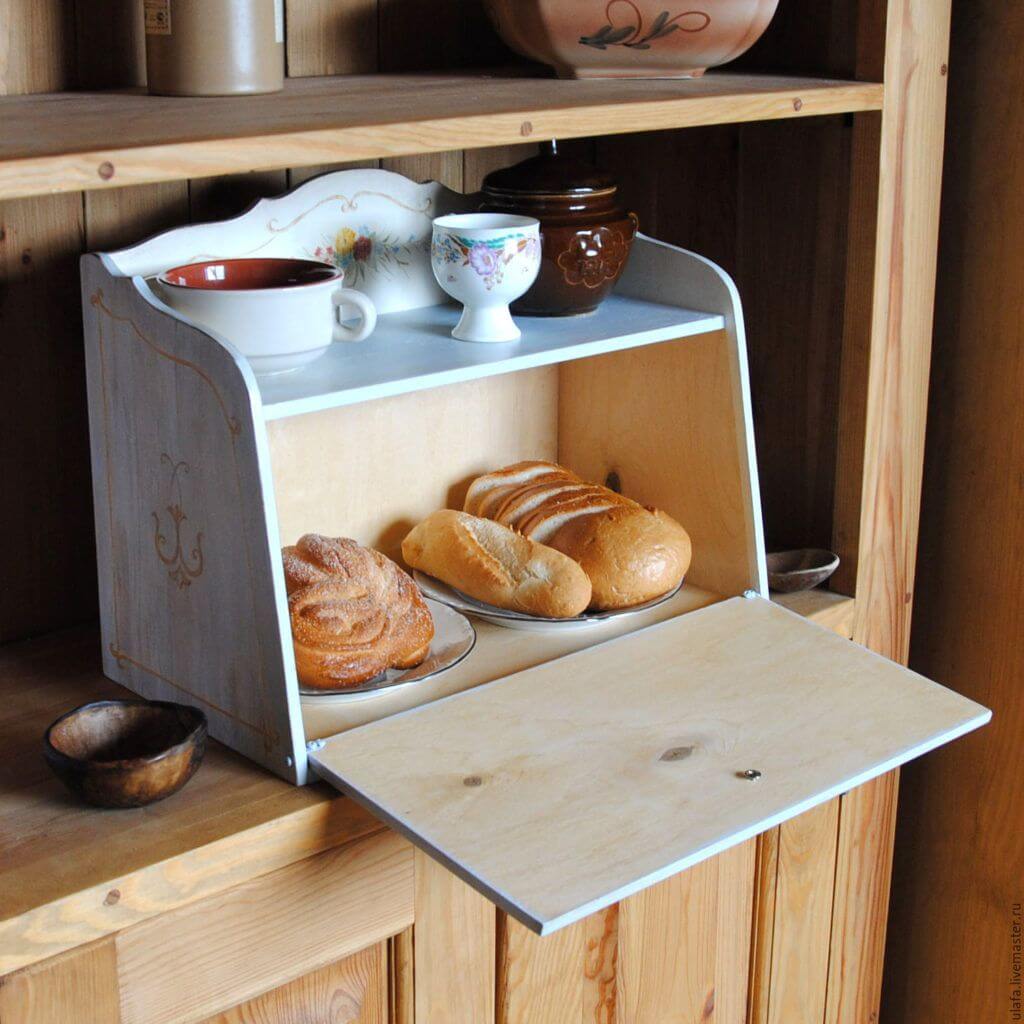
In the lower cabinets, it is convenient to use a drawer for this purpose. Be sure to make a metal, wooden or plastic cover.
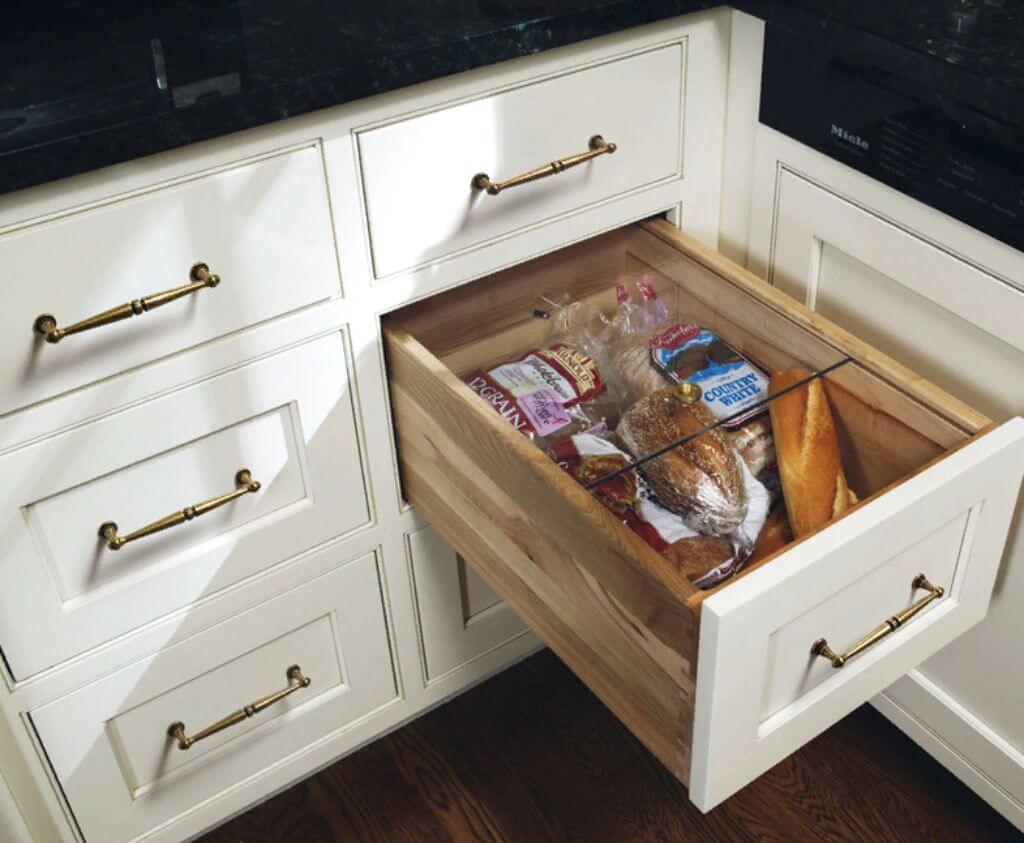
The bread box in the interior of the kitchen can be suspended. Choose rails, ordinary screws or hooks.
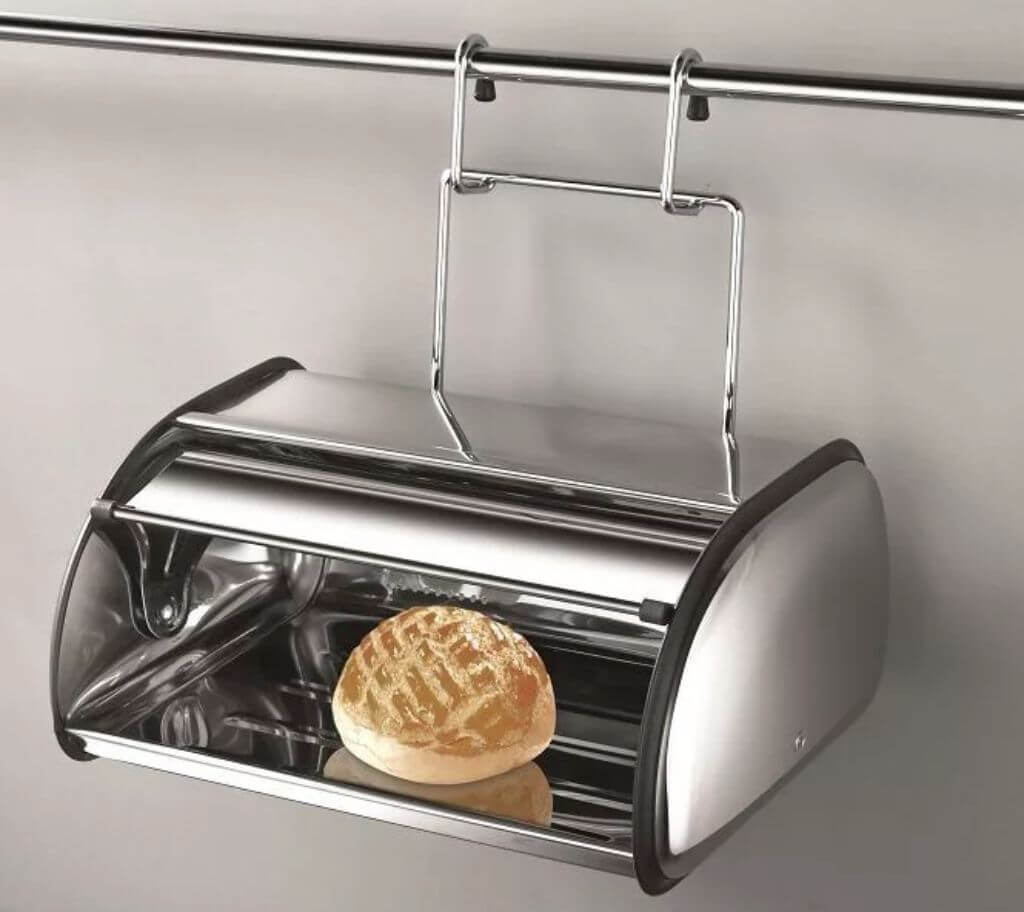
One of the options for saving kitchen space is corner placement. Prudently choose a section of the wall away from the stove and sink.
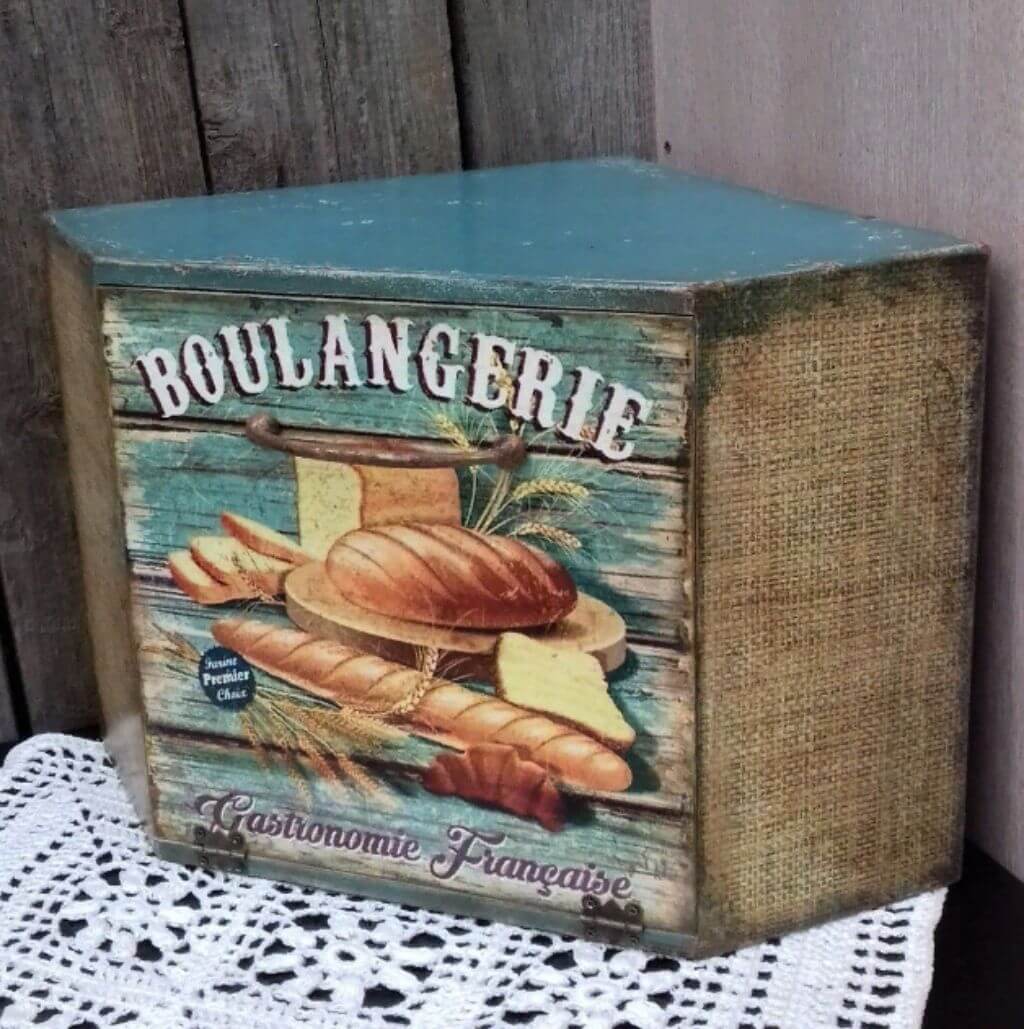
An old bread box will make an exclusive interior detail if you pick up a creative idea. You can simply prime and paint, use decoupage for metal, burning and wood painting.
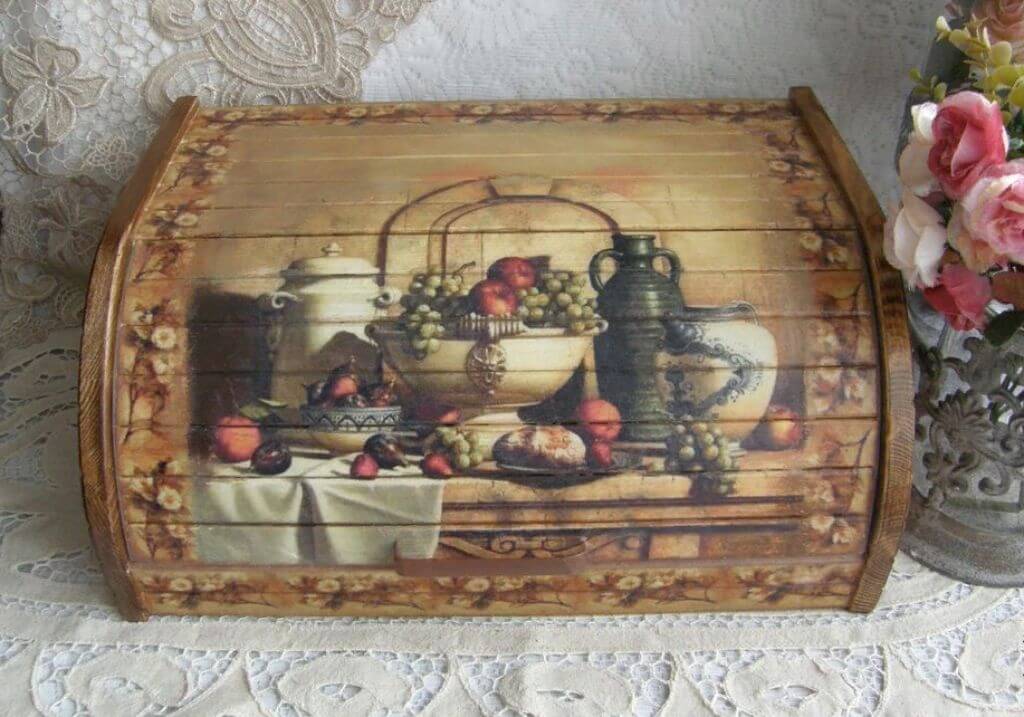
The Procedure For Cleaning The “Bread Place”
- The bread rack and bread box are regularly washed and dried thoroughly.
Humidity is the enemy of any bread, rye or wheat, yeast-free or rich.
Both in containers and in cabinets, it is necessary to carry out regular antiseptic treatment with neutral means – detergents without fragrances, laundry soap, baking soda, vinegar.
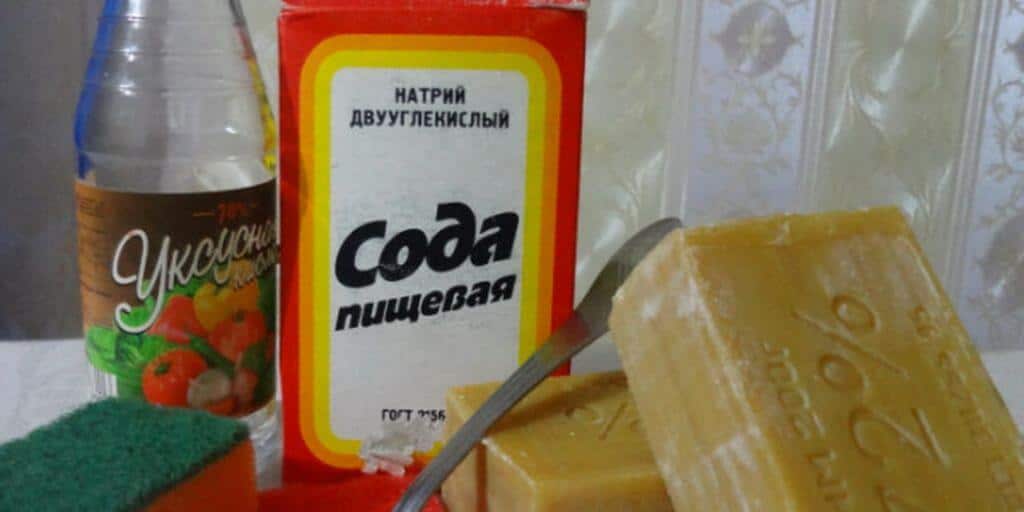
How To Revive Stale Bread: 10 Ideas With Stale Bread
Callousness is not a reason to throw away bread. If it has not had time to dry completely, you can try to return the structure to its usual softness. The moldy piece will have to be thrown away.
How to revive bread:
- moisten in water, place in a bag, container or form with a lid. Keep in the oven or microwave for a few minutes. The amount of water depends on the hardness. For a couple of days in the refrigerator, it will be enough to sprinkle the crust;
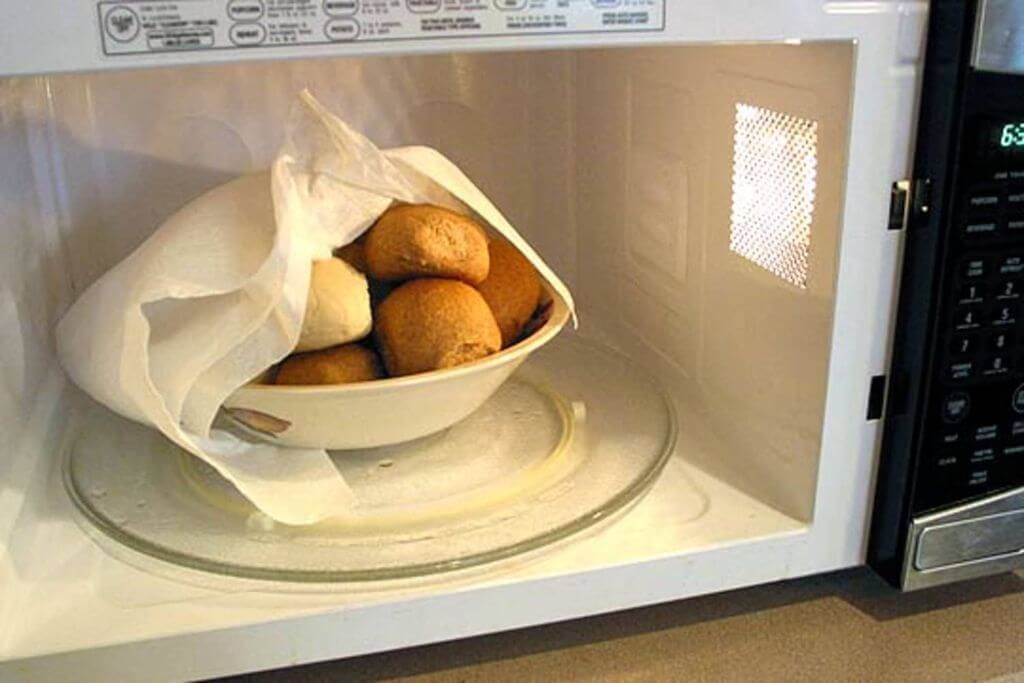
- steam the pieces for a couple of minutes in a colander in the bath. Serve or pack tightly, otherwise the moisture will quickly evaporate.
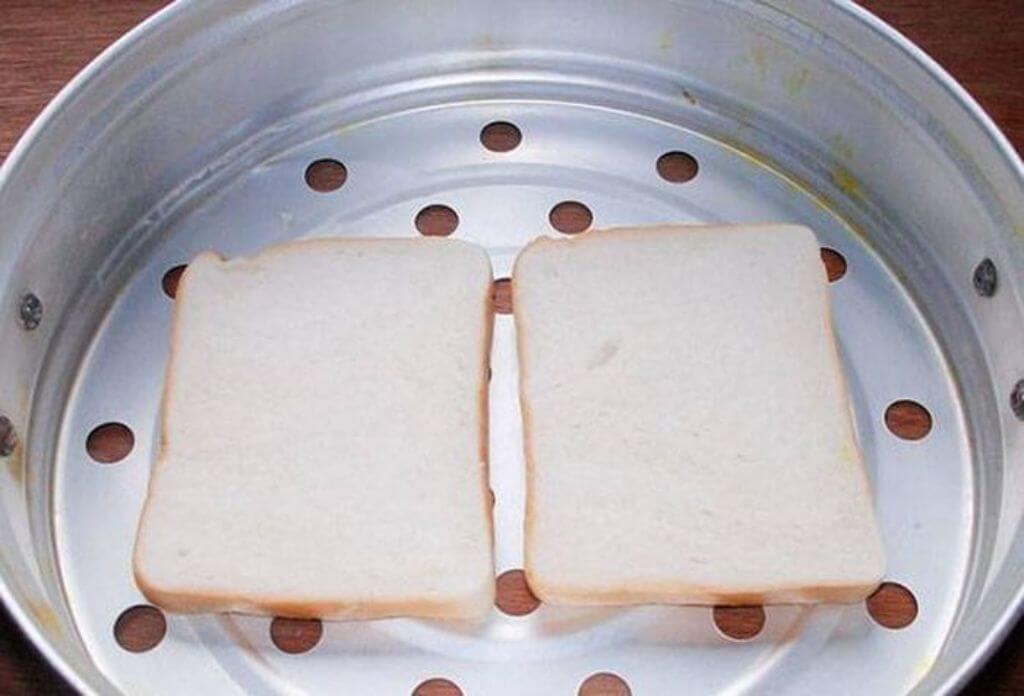
Crackers are suitable for preparing some dishes and drinks. 10 ideas for stale or dried bread:
- Sugar bowl
A suharnitsa was baked in Russian ovens. Beat 3 eggs and 3 tbsp. milk. Lubricate the baking dish with butter, where they put 100 g of rye or wheat crackers. Pour the egg-milk mixture and after half an hour of exposure, bake for half an hour in a well-heated oven.

- Breading
Crushed wheat crackers are used as breadcrumbs for cutlets, chops. It is important that they are from bread without seeds, fruit and other additives. Stale bread is rubbed and stored in the freezer or dried in the oven.
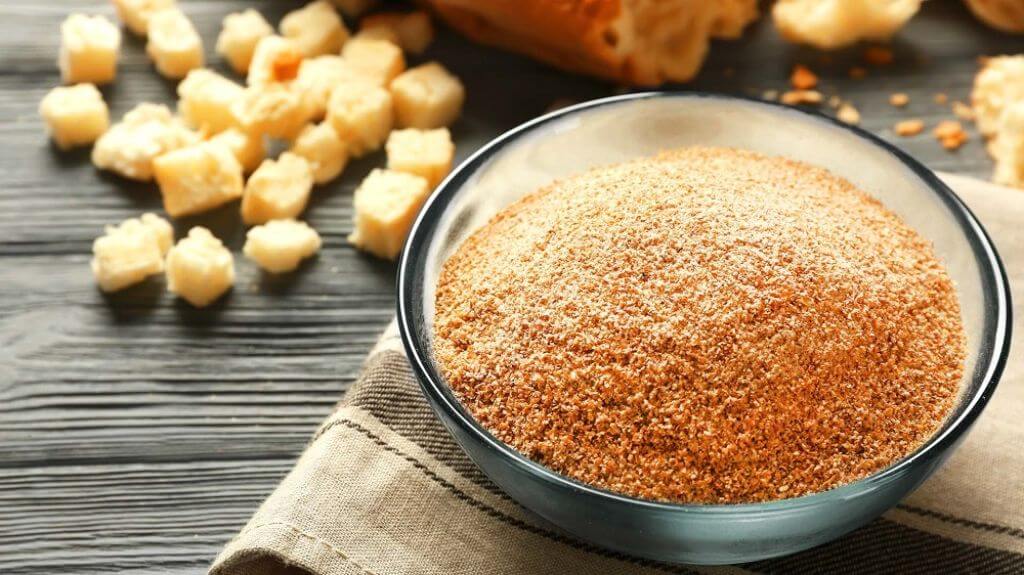
- With dumplings
White bread crackers are an excellent addition to cottage cheese dumplings. For this purpose, the bread is finely chopped or rubbed on a coarse grater, dried. Add to the finished dish, pouring with melted butter.

- Kvass
Kvass on rye crackers is prepared for okroshka or drinking, to which raisins and additional sugar are added. Rye stale bun should be cut into pieces about 1 cm in size and dried until dark at 180 ° C.
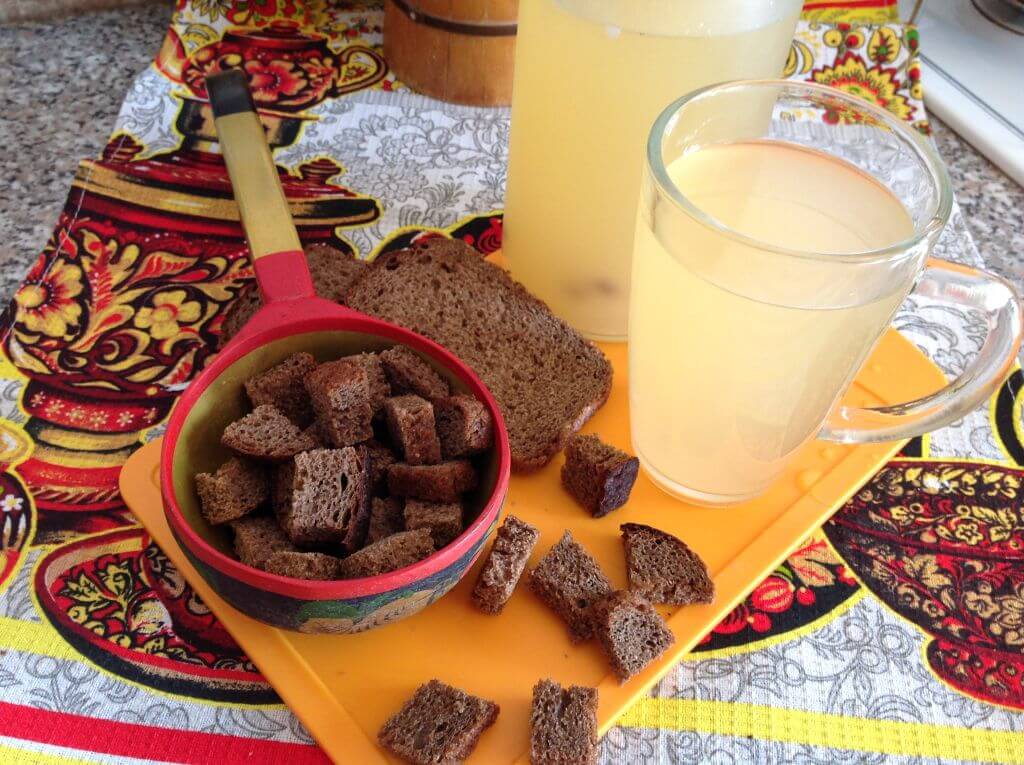
200 g of crackers pour 3 liters of boiling water, add 3 tbsp. sugar, stir and wait for it to cool to room temperature. 20 g of fresh yeast is diluted in a glass of warm rusk water and left until the foam cap rises. Mix with the rest of the solution, cover with a cloth and put in a warm place for 2 days. Strain kvass into a jar. For drinking add 5-6 raisins and leave for another day.
- Cake for tea
Cut bread or dried loaf. Fold the pieces in pairs, layering with any jam. Spread butter on top and cut into strips. Oil is dipped in sugar and placed on a leaf. Bake at 200°C for 10 minutes.

- Toast
Dried pieces of bread are dipped in eggs, beaten with milk, fried on both sides. A mixture of 1 egg and a glass of milk is made sweet (sugar, honey to taste) or savory (salt, garlic, pepper).

- Salad with chicken
Cut into pieces 300 g of boiled chicken fillet, 200 g of hard cheese, 300 g of canned corn, 200 g of crackers. Fill with 200 g of mayonnaise, mix. Leave for a couple of hours in the refrigerator to soak the crackers, then serve.
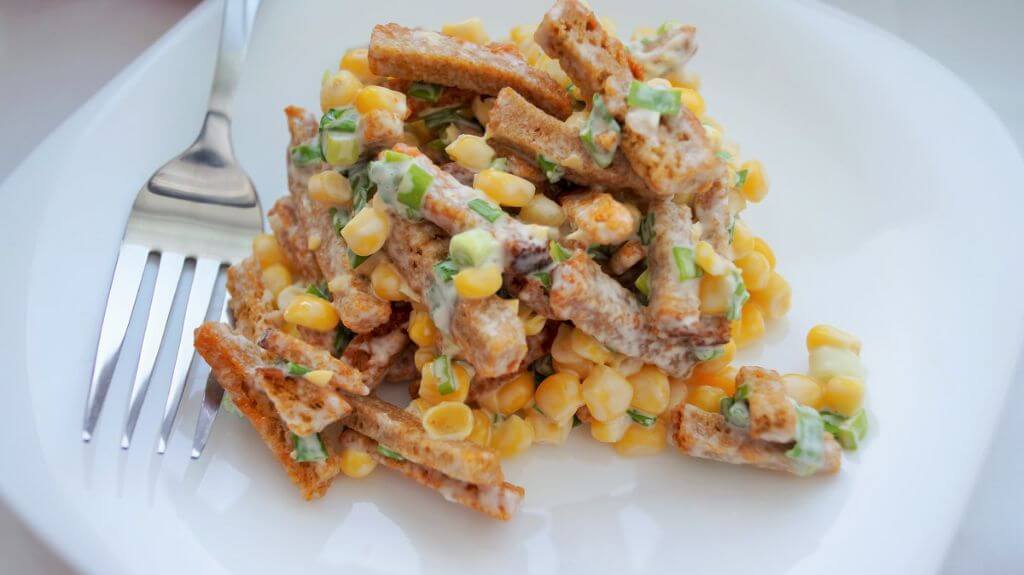
- Dessert with fruits
Crackers are laid out in layers in a deep form, alternating with flatly cut apples or other fruits. Pour each layer of crackers with a beaten mixture of eggs and sugar. In order to make the cake more tender, before sending it to the oven, it is kept for 40 minutes on the table.
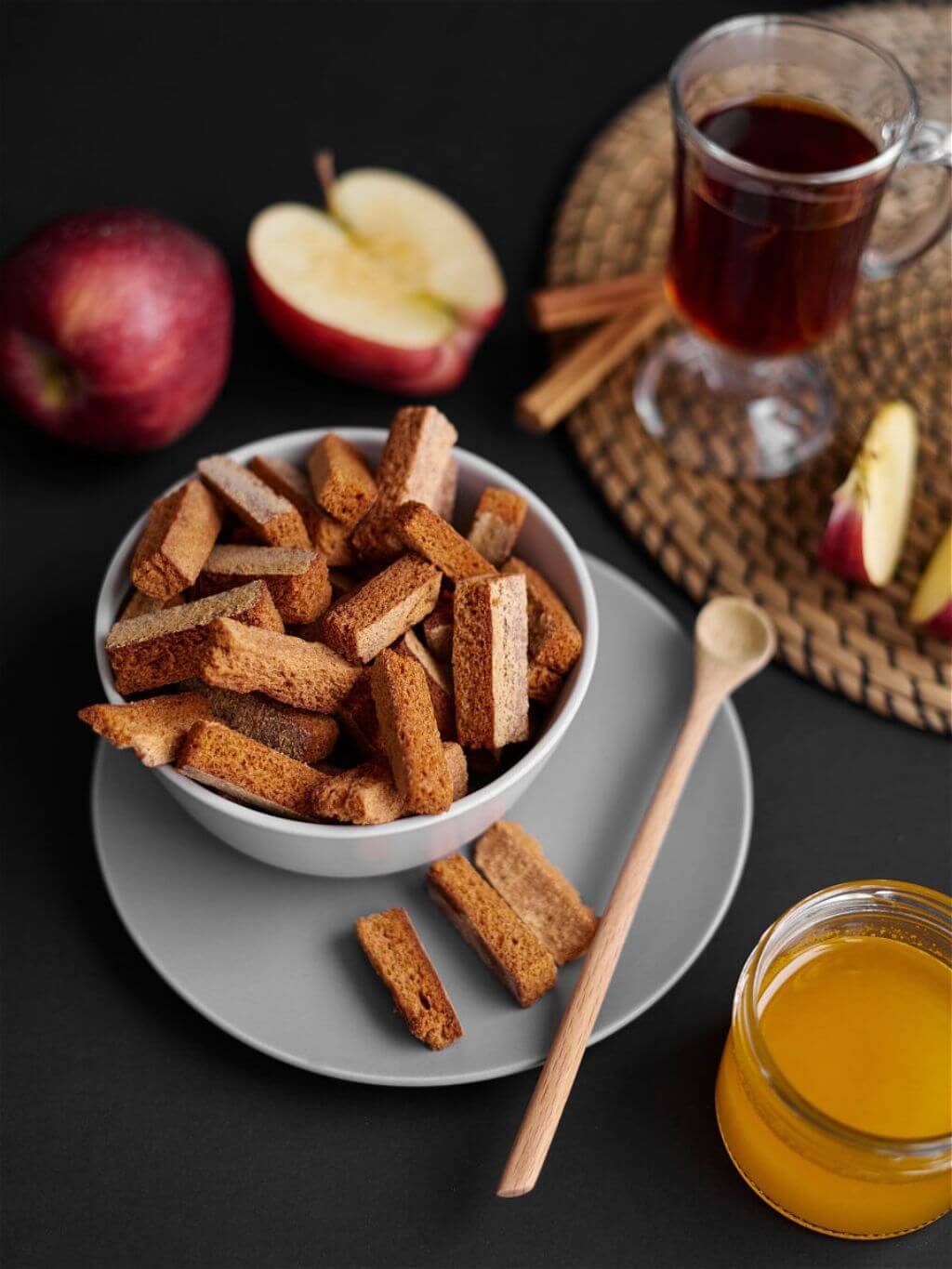
- Fritters
Mix 2 cups of grated crackers and a glass of milk, leave to swell. Add 2 eggs, finely chopped onion. Fried in oil like pancakes. Served as an independent dish with sour cream and as a side dish for meat.

- Rum cake
2 tablespoons of flour are fried in 2 tablespoons of butter until golden brown. Pour 1.5 cups of milk, add 2 tablespoons of sugar and heat until it thickens. The mass is mixed with 500 g of grated crackers (preferably from rich buns), a spoonful of rum or cognac, if desired, add a spoonful of instant coffee, nuts, candied fruit.
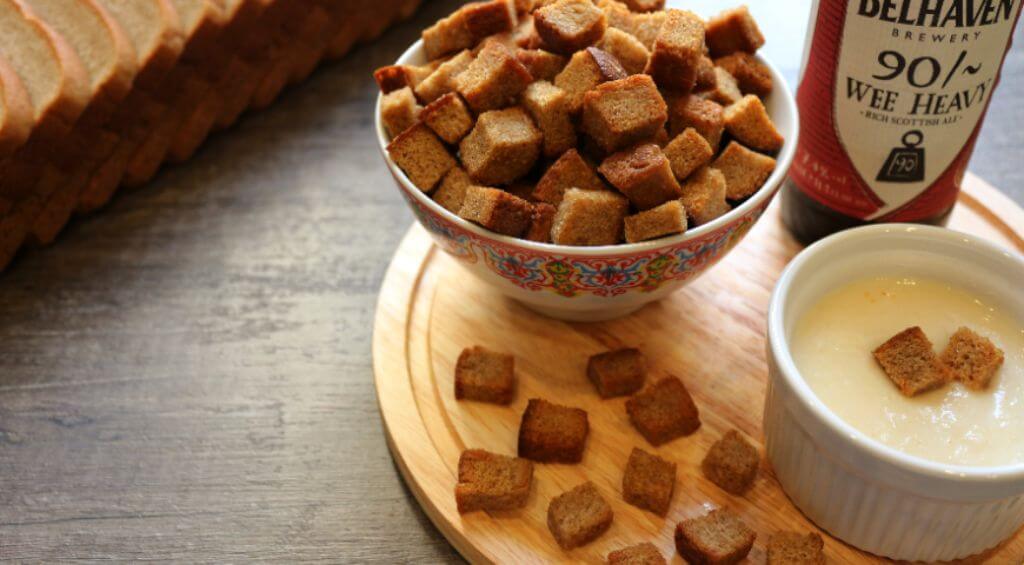
Form a tourniquet and cut into pieces. Keep an hour in a cold place, cover with chocolate icing.
Life Hacks For Young Housewives
How to keep fresh bread fresh from the store or baked in a bread machine:
- Put a slice of lemon into the breadbasket. Lemon will give a pleasant aroma and protect against shrinkage, but after 2-3 days they change it, because it starts to deteriorate.

- A piece of raw potato can humidify the air. For the method to work, the potatoes are updated every day. Do not allow bread to come into contact with a wet root crop.
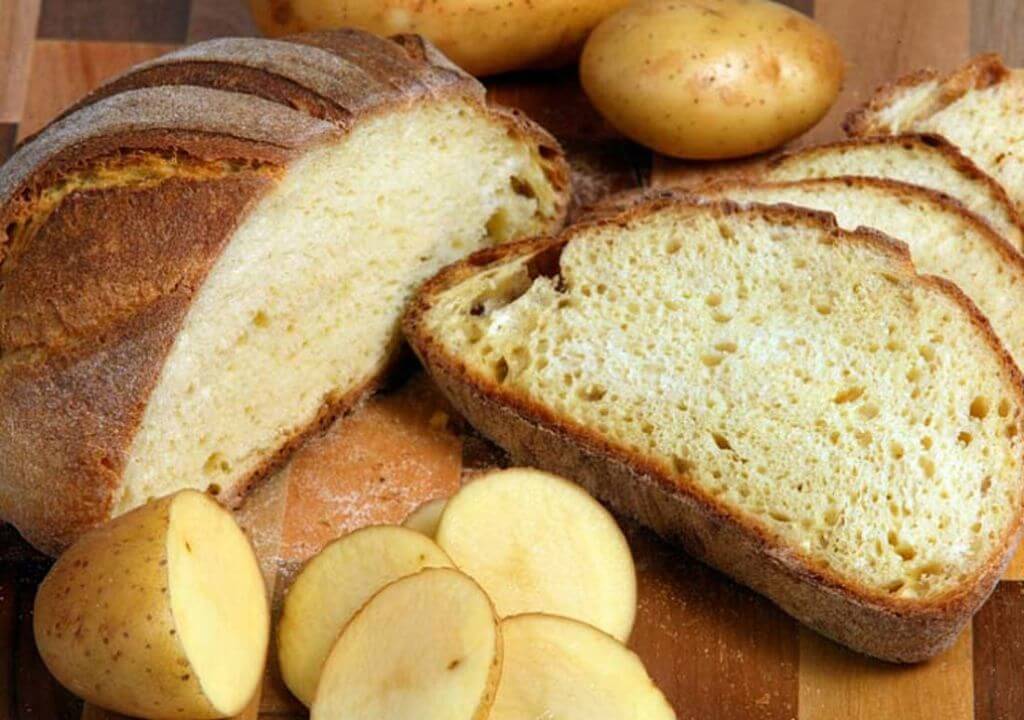
- A handful of salt in a bread box will absorb moisture and protect against mold.

- Place in a cloth bag and then in a plastic bag.
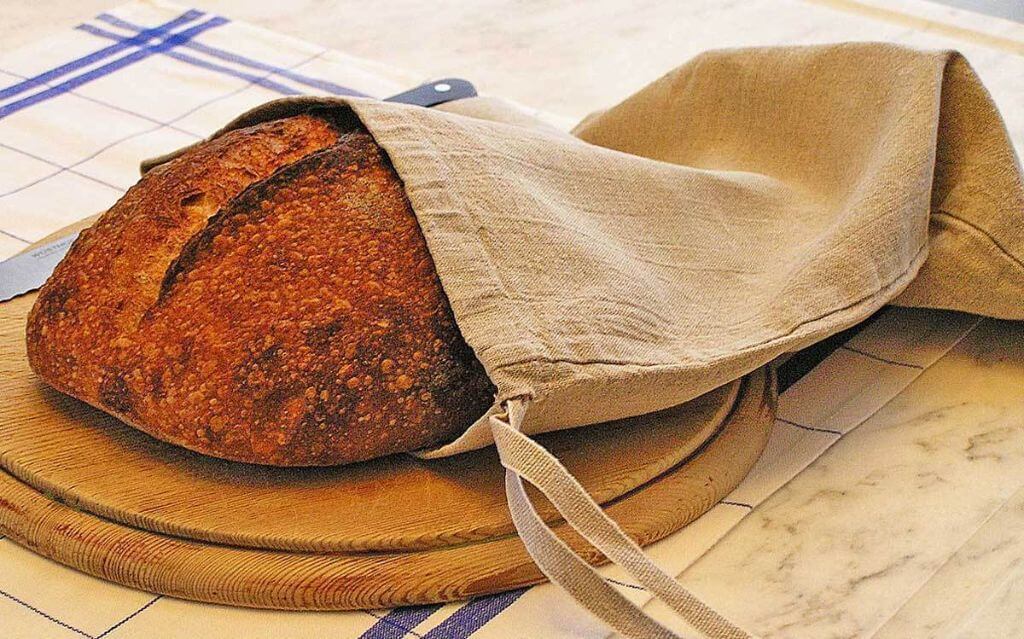
- Cut the bun in half, cut a slice from the middle. Fold the rest of the pieces together again so that the crumb is closed.

Real bread, made according to traditional recipes, has been and will be a guest of honor on the table. It is not only satisfying, but also contains B vitamins. Since the taste and benefits are preserved only with proper storage, bakery products are given a separate place in the kitchen. It can be advised to buy the product in limited quantities. If you rarely get to the store, you can keep the bread in reserve in the freezer.




